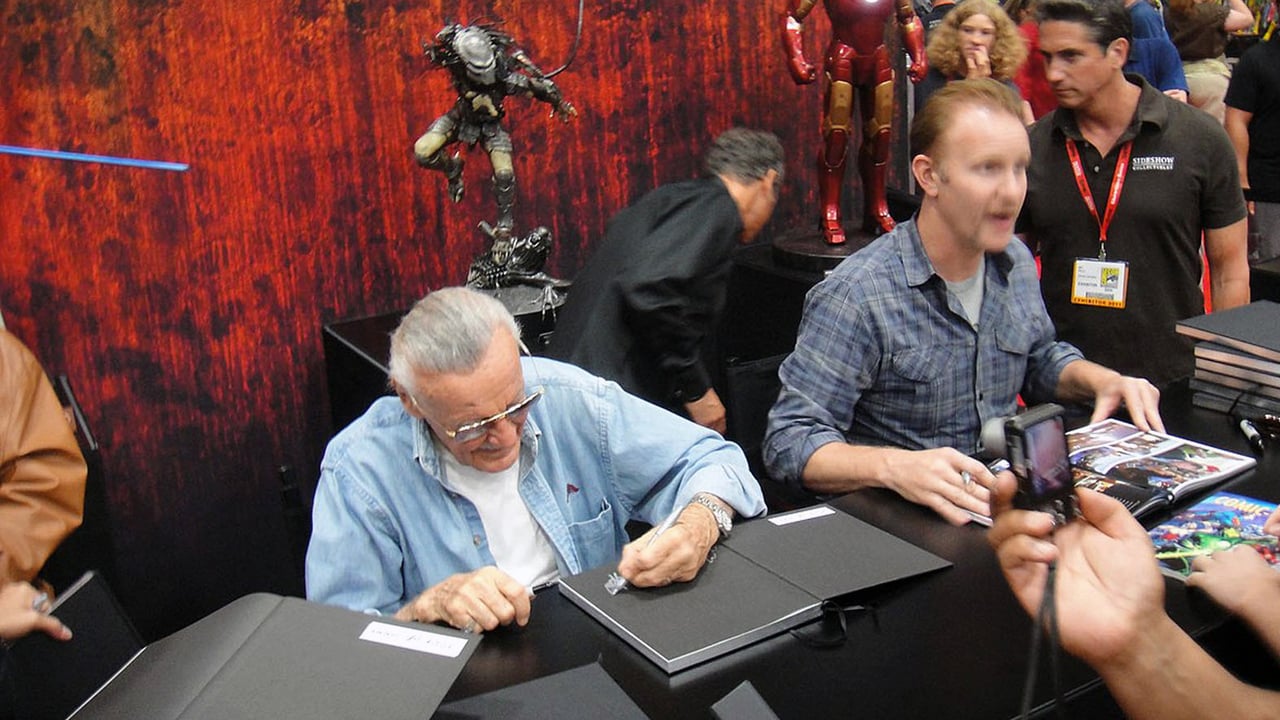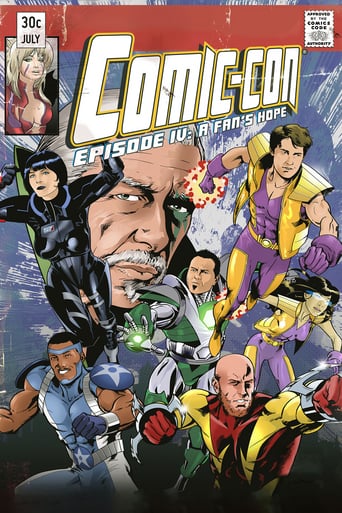

What is the matter with the makers of this documentary? They included one token female voice among a huge number of of fan boys. All other females were either being proposed to by their geek boyfriend or seen in the background and referred to as "slave girls". That is incredibly offensive.The longer I watched, the more glaring the lack of females became. Though some of it was interesting, it was way too long for me, but once I started getting uncomfortable because of the overwhelming absence of women, I had to sit through the whole thing to see if all of it was really that bad. It was.I really have to wonder why women are invisible to the makers of this film. Is it sexual revulsion? Mental illness? There really is no excuse for this sort of thing.
... View MoreThe biggest reason I watched this documentary was that it was co-produced and directed by Morgan Spurlock--and he always seems to make interesting films. However, I was very surprised at the style of the film, as it's nothing like his other movies and you don't see him at all during the picture. Instead, you simply are taken to ComicCon in San Diego and get to see the sights as well as follow a few nice folks there. There are also LOTS of interviews with the royalty in the geek world. This made the film very free-flowing and natural--like a REAL experience in going to this convention as well as getting a personal interview with these people. Now considering it's practically impossible to get tickets (believe me, my daughter has tried!), it's the best most people can do. My only complaint? I would have liked to have seen more! Highlights--seeing the guy propose, the AMAZING cos-play team and the guy who wanted to become a comic artist AND succeeded amazingly well!
... View MoreSan Diego Comic-Con International began in 1970 as a one-day only convention in which comic book fans gathered in the basement of the U.S. Grant Hotel and bought and traded magazines. A little over 100 people were in attendance. That, according to original founders Mike Towry and Richard Alf, was considered a successful turnout. Could they have foreseen that it would balloon into an annual pop culture phenomenon that in recent years never had less than 100,000 people in attendance? Although they are still given areas for showcasing, it isn't so much about comic books anymore; major media companies, especially TV networks and movie studios, vie for space to promote their latest productions, with big name Hollywood celebrities and filmmakers serving as hosts for gigantic press panels.I have never attended Comic-Con, and quite frankly, I have no desire to ever attend. One of the reasons I appreciated "Comic-Con Episode IV: A Fan's Hope," Morgan Spurlock's newest documentary, is that it allows people like me to view the convention from a safe distance – no heartbreak from not getting into sold-out events, no waiting in obscenely long lines, no pushing or shoving through densely packed crowds, no chance of being deafened by cheering throngs, no risk of getting into fights with frothing fanboys over a misunderstanding. We obviously aren't show every nook and cranny of the San Diego Convention Center, but we do get wonderful snapshots of the major events, the most prominent being the celebrity press panels in a 6,500-seat venue known as Hall H."A Fan's Hope," a joint venture between Spurlock and executive producers Stan Lee, Joss Whedon, and Harry Knowles, is an entertaining mixture of convention footage, subject interviews, and fan testimonials. While a few of the latter are given by anonymous attendees, most are given by celebrities, all of whom feel a personal connection to Comic-Con and its community. Whedon, Knowles, and Lee all make statements, but so too do Frank Miller, Seth Green, Seth Rogen, Thomas Jane, Eli Roth, Olivia Wilde, and most amusingly, Kevin Smith. Noticeably absent is Spurlock himself. Indeed, this is the first of his documentaries in which he neither makes an appearance nor provides a narration. This begs the question of why he feels so attracted to Comic-Con. Whether or not you agreed with his previous documentaries, his appearances in them made it clear that he had vested interest in his subjects.Filmed during the 2010 convention, the film documents the lives of six fans, all given nicknames, all of whom hail from different parts of America and have deeply personal reasons for attending. We have Skip Harvey and Eric Henson. The former tends a sci-fi themed bar while the latter currently serves in the U.S. Air Force. Both are talented illustrators who dream of being hired by a major comic book publisher. Armed with portfolios, they wait in long lines to have their work critiqued by trained representatives. We have James Darling and his girlfriend Se Young Kang, who immediately hit it off after first meeting at Comic-Con a few years earlier. James now wants to propose to Se Young in grand fashion, namely during a panel hosted by Kevin Smith. For all his planning and coordination, the one thing James didn't count on was Se Young refusing to leave his side for even a few minutes. This will be a tricky one to pull off.The two most compelling subjects are Holly Conrad and Chuck Rozanski. The former is a young costume/creature designer and seamstress; she, along with a group of friends, participates in Comic-Con's Masquerade Ball dressed as characters from the video game "Mass Effect." Naturally, the costumes were all meticulously hand crafted by herself. One of her friends dresses as an alien creature, one that requires the use of a motorized latex head. The end result could easily rival a theme park animatronic. The latter is the owner of a Mile High Comics store in Denver, one that's struggling to turn a profit. He brings with him his most prized possession: A mint-condition first issue of "Red Raven," one of the rarest comic books ever published. Understandably, he laments the fact that Comic-Con has over the years veered further and further away from its original intended purpose.That doesn't seem to have stopped it from happening, and it certainly hasn't stopped anyone from attending. In fact, the 2010 convention currently holds the record for having the largest attendance –130,000-plus. I grant you that it's a rather bland fact, although I suspect that if we had been given such statistics, "Comic-Con Episode IV: A Fan's Hope" might have been an even more enlightening documentary. Seeking a layman's explanation for the convention's appeal, I consulted friends and fellow film critics Mike and Joel Massie, who have both attended Comic-Con annually since 2006. Not surprisingly, they see it only from a moviegoer's perspective. "It's really about seeing celebrities," Mike told me, "watching advanced footage and seeing exclusive tidbits about movies that are sometimes years in advance." I, for one, am far more comfortable living with the anticipation.-- Chris Pandolfi (www.atatheaternearyou.net)
... View MoreFilmmaker Morgan Spurlock brings his usual care and attention to a subject that, this time, sadly never gets it. From fast food, to terrorist-hunting, to product placement, and now to the largest convention in North America, Spurlock has proved diversity and that if you add the right balance of seriousness and wittiness to any subject, you'll be able to create a wonderful documentary. That's exactly what he does with Comic-Con Episode IV: A Fan's Hope.To my knowledge and research, this is the first documentary ever made focusing on the convention itself. Sure, when it happens in July we have updates on the web, and VLogs from a number of people, but nothing has ever been compiled into a full length movie. Spurlock chooses to follow along four people who are traveling to the convention from all walks of life, with different goals in mind.They are "The Geek" (Skip Harvey, a bartender hoping to write a graphic novel and get feedback on his artwork at the convention), "The Solider," (Eric Henson, also hoping to become a comic book artist to support his wife and kids), "The Designer," (Holly Conrad, a young woman in a small, concise town who is designing costumes for a Mass Effect reenactment she hopes to put on), and "The Survivor," (Chuck Rozanski, a struggling-comic book store owner who is hellbent on making a huge profit by selling hundreds of comics at the convention. Including the extremely rare, first issue of Marvel's "Red Raven" which can command thousands of dollars online).In the mix of chronicling these four strangers, Spurlock also sets his sights on getting opinions and commentary from actors and directors who have been to the Con themselves. One of them is Kevin Smith, my favorite director, who attends Comic-Con to provide a monstrous Q&A session in the largest room of the convention. Other celebrities include Hostel director Eli Roth, stating that there is absolutely nothing wrong with having a passion for something you liked when you were young, Knocked Up star Seth Rogen, and comic book king Stan Lee.We also follow a man who proposed to his girlfriend at Kevin Smith's panel last year at Comic-Con, as well as seeing a toy collector who is determined to acquire another entry in his prized collection, much to the dismay of his wife.These people are genial, optimistic, and effortlessly likable. They aren't wallflowers, who sit back and expect to be taken under the wing immediately without contributing some amount of effort. They take the steps necessary in order to achieve their big goals. Comic book store owner Chuck seems to be the odd-man out when stating this, but if you look at his persistency, continuing to have faith in the comic book community and constantly spending money to run his store, he is truly fighting just as hard as the other subjects in the film. He already has his dream, he's just fighting to keep it.The one downside with the documentary is Spurlock, himself, has virtually no part in the film whatsoever. This is quite a shame, seeing as we can see just by the way he captures the footage and edits it together (not to mention, last year, he wrote a book about the convention with the same title as the film) that he has a true love for the Con and the crowd it draws. Why doesn't he ever interact with the four subjects or the crowd themselves? It's a bummer because on top of him already remaining silent, it almost seems he doesn't have any questions for the people, when we already know that is highly unlikely. Spurlock seems to sit back and watch the fun happen, without ever getting involved or enjoying it for himself.I would still call Comic-Con Episode IV: A Fan's Hope a documentary that needed to be made. As I've grown older, I've found it important to look at all walks of life with an open mind, and to see documentaries further illustrate that idea is wonderful. This is definitely an eclectic and ambitious film, not only documenting an extremely popular convention, but the kinds of people you'll find there. From what I hear, that's half the fun of going.Starring: Skip Harvey, Eric Henson, Holly Conrad, Chuck Rozanski, Kevin Smith, Seth Rogen, Eli Roth, and Stan Lee. Directed by: Morgan Spurlock.
... View More